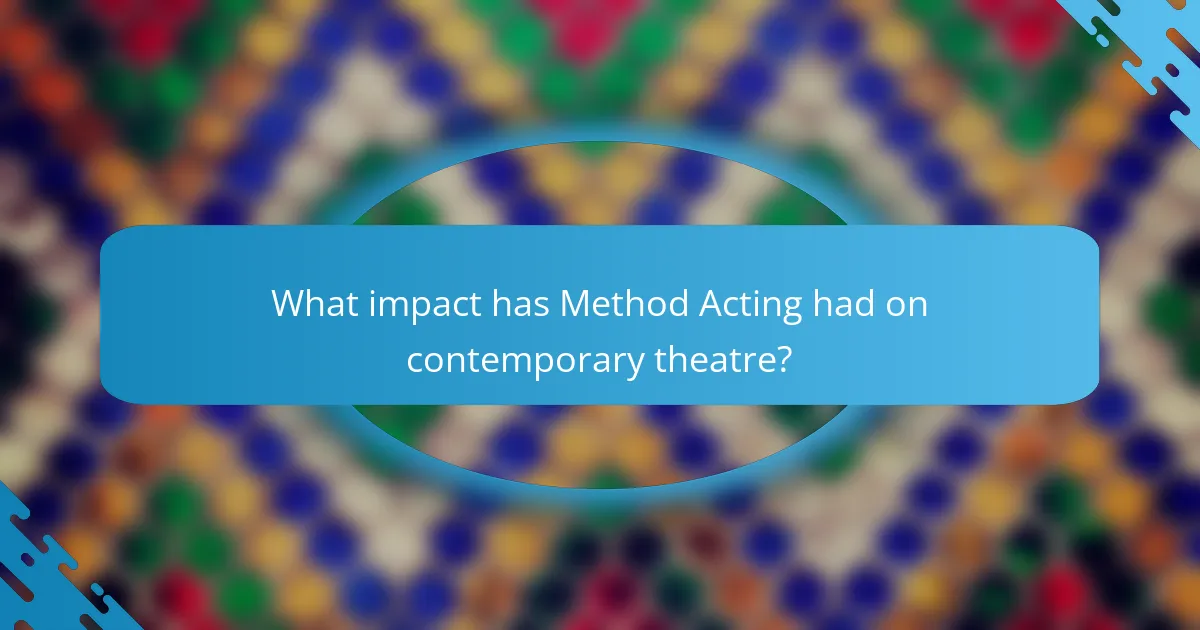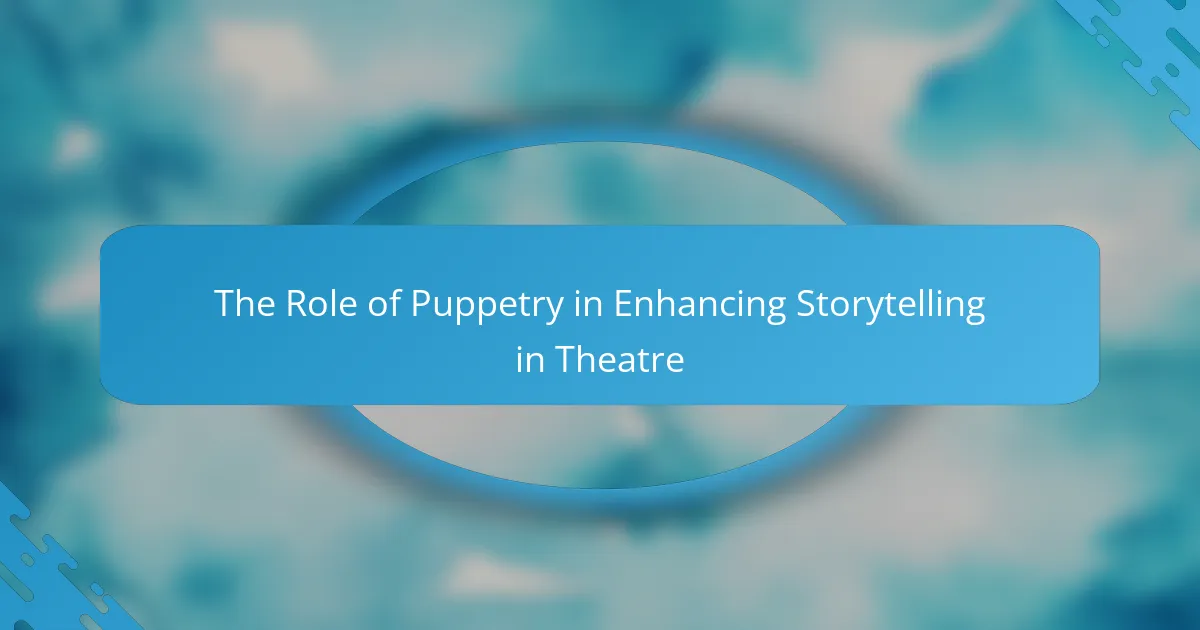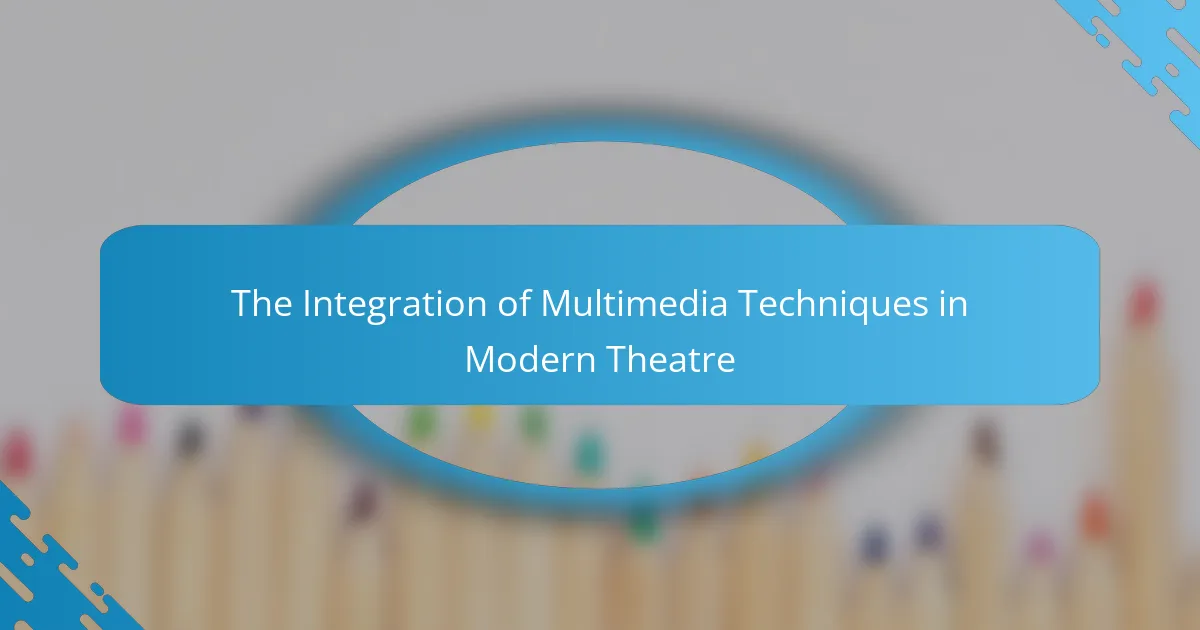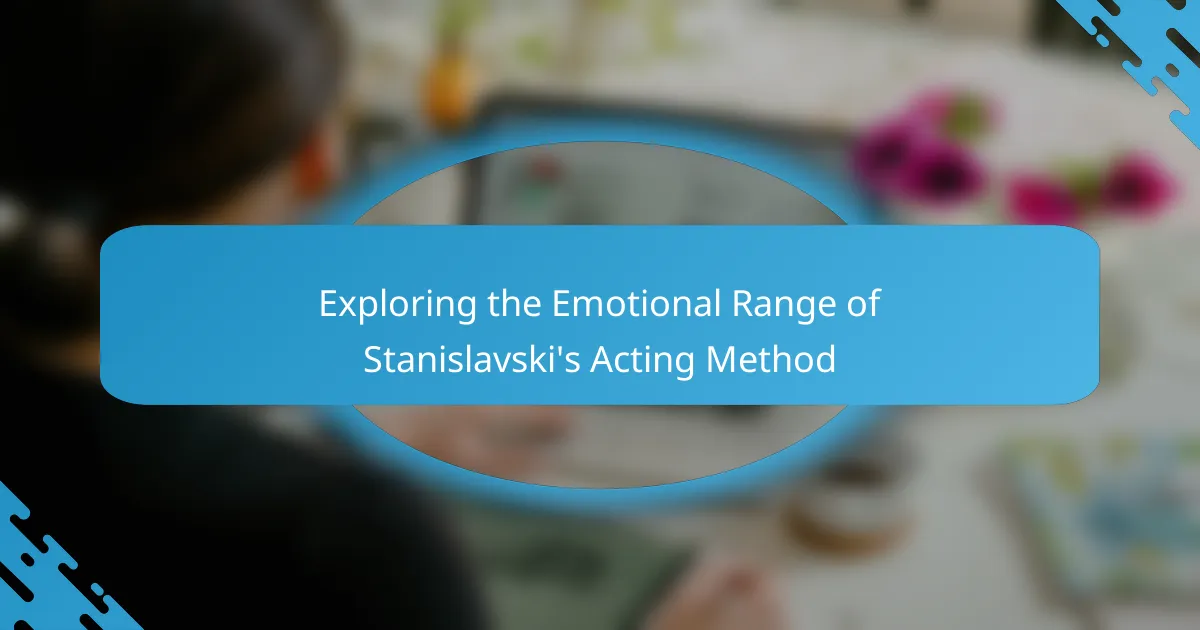Method Acting is a prominent technique in theatre that emphasizes emotional authenticity and psychological realism, encouraging actors to draw from their personal experiences. Key methods within this approach include sense memory, emotional recall, and improvisation, each designed to enhance the actor’s connection to their character. Influenced by pioneers like Stanislavski and Lee Strasberg, Method Acting has evolved to incorporate various interpretations, such as the Meisner Technique, which focuses on spontaneous reactions. This technique has significantly shaped contemporary theatre by fostering relatable and impactful performances, ultimately raising audience expectations for realism in acting. Notable actors, including Marlon Brando and Al Pacino, exemplify the effectiveness of Method Acting in delivering nuanced portrayals that resonate deeply with viewers.

What are Method Acting Techniques in Theatre?
Method acting techniques in theatre are approaches that emphasize emotional authenticity and psychological realism. These techniques encourage actors to draw on their personal experiences to create genuine performances. Key methods include sense memory, emotional recall, and improvisation. Sense memory involves recalling sensory experiences to evoke emotions. Emotional recall requires actors to tap into their past feelings to portray a character’s emotions convincingly. Improvisation allows actors to react spontaneously, fostering organic interactions. Developed by Lee Strasberg and influenced by Stanislavski, these techniques have shaped modern acting practices. Their effectiveness is evidenced by acclaimed performances in film and theatre.
How did Method Acting originate in the theatrical world?
Method Acting originated in the theatrical world through the teachings of Konstantin Stanislavski. He developed a system focused on emotional authenticity and psychological realism. Stanislavski’s approach emphasized the actor’s inner experience and personal connection to the character. This method was designed to create more believable performances. The system was introduced in the early 20th century at the Moscow Art Theatre. It influenced many actors and directors in the United States. Lee Strasberg later adapted Stanislavski’s techniques into what is now known as Method Acting. This adaptation further popularized the practice in American theatre and film.
What key figures contributed to the development of Method Acting?
Key figures who contributed to the development of Method Acting include Lee Strasberg, Stella Adler, and Sanford Meisner. Lee Strasberg is known as the “father of Method Acting.” He emphasized emotional memory and personal experience in performance. Stella Adler focused on the importance of imagination and character analysis. She believed in using the actor’s creativity to enhance performance. Sanford Meisner developed the Meisner Technique, which stresses the importance of listening and reacting authentically. These figures collectively shaped the principles and practices of Method Acting in theatre. Their teachings continue to influence actors and acting schools today.
What historical context influenced the rise of Method Acting?
The rise of Method Acting was influenced by the social and political upheavals of the early 20th century. The development of realism in theatre paralleled movements such as the Industrial Revolution and World War I. These events led to a demand for more authentic and relatable performances. The psychological theories of figures like Stanislavski emphasized emotional truth and personal experience in acting. This approach resonated with audiences seeking deeper connections to characters. Additionally, the establishment of acting schools in the United States, such as the Actors Studio, helped popularize Method Acting techniques. These schools trained actors to draw from their own emotions, enhancing the realism of performances.
What are the core principles of Method Acting?
Method Acting is characterized by several core principles. These principles include emotional recall, sense memory, and the importance of authenticity. Emotional recall involves tapping into personal emotions to portray a character’s feelings. Sense memory focuses on using physical sensations to evoke emotions. Authenticity emphasizes genuine performances that resonate with audiences. These principles were developed by Lee Strasberg and are rooted in the teachings of Konstantin Stanislavski. Method Acting aims to create a deep connection between the actor and the character. This approach has influenced countless actors and remains a significant technique in theatre today.
How do emotional memory and sense memory play a role in Method Acting?
Emotional memory and sense memory are crucial components of Method Acting. Emotional memory involves recalling personal experiences to evoke genuine emotions during a performance. This technique allows actors to connect deeply with their characters. Sense memory, on the other hand, focuses on recalling physical sensations to enhance the realism of a performance. Actors use sense memory to recreate specific feelings associated with past experiences. Both methods help actors achieve authenticity in their roles. Research by Lee Strasberg emphasizes the importance of these techniques in developing a truthful portrayal. Strasberg’s approach has influenced countless actors and remains foundational in Method Acting training.
What techniques are used to create authentic character portrayals?
Authentic character portrayals are created using techniques such as emotional memory, improvisation, and deep character analysis. Emotional memory involves actors recalling personal experiences to evoke genuine feelings. This technique helps actors connect with their characters on a personal level. Improvisation allows actors to explore their characters’ reactions in spontaneous situations. This can lead to more natural performances. Deep character analysis requires understanding the character’s background, motivations, and relationships. This thorough understanding informs the actor’s choices and actions. Research by Lee Strasberg emphasizes the importance of these techniques in method acting. Strasberg’s approach focuses on psychological realism to enhance authenticity in performances.
How has Method Acting evolved over time?
Method Acting has evolved significantly since its inception in the early 20th century. Originally developed by Konstantin Stanislavski, it focused on emotional authenticity and psychological realism. In the 1940s, Lee Strasberg adapted these principles, emphasizing the actor’s personal experiences to evoke genuine emotions. This adaptation led to the establishment of the Actors Studio in New York, which became a training ground for many renowned actors.
In the 1960s and 1970s, Method Acting gained popularity in film, influencing actors like Marlon Brando and Al Pacino. Their performances showcased intense emotional depth, further solidifying the technique’s relevance. Over time, Method Acting has incorporated various psychological and physical techniques, such as sensory memory and improvisation.
Today, it is widely taught in drama schools and has influenced multiple acting styles. The evolution of Method Acting reflects a continuous pursuit of authenticity in performance, adapting to cultural shifts and new artistic expressions.
What significant changes have occurred in Method Acting techniques?
Significant changes in Method Acting techniques include a shift towards more psychological approaches. Traditional Method Acting focused on emotional recall and personal experience. Contemporary techniques emphasize character immersion and physicality. Actors now often utilize sensory memory and improvisation more extensively. There is also a greater focus on ensemble work and collaboration. These changes reflect the evolving landscape of theatre and film. The adaptation of techniques has been influenced by modern psychological theories. This evolution enhances the authenticity and depth of performances.
How have cultural shifts influenced the evolution of Method Acting?
Cultural shifts have significantly influenced the evolution of Method Acting. The rise of realism in theatre during the late 19th century prompted actors to adopt more immersive techniques. This shift was fueled by societal changes, including the exploration of psychology and individualism. The introduction of psychoanalysis by figures like Sigmund Freud encouraged actors to tap into their emotional experiences. The civil rights movement in the 1960s also impacted Method Acting, promoting diversity in casting and storytelling. This led to a broader representation of characters and experiences on stage. Additionally, the feminist movement challenged traditional gender roles, influencing how characters were portrayed. These cultural dynamics continually reshape Method Acting, making it more relevant to contemporary audiences.

What are the different approaches within Method Acting?
The different approaches within Method Acting include Stanislavski’s system, Lee Strasberg’s interpretation, and Meisner Technique. Stanislavski’s system emphasizes emotional memory and the actor’s personal experiences. Lee Strasberg adapted this approach, focusing on sense memory and affective memory to evoke genuine emotions. The Meisner Technique prioritizes spontaneous reactions and truthful interactions between actors. Each approach aims to deepen the actor’s connection to their character and the performance. These methods have evolved to enhance authenticity in acting, reflecting the psychological complexities of human behavior.
How do various schools of thought interpret Method Acting?
Various schools of thought interpret Method Acting as a technique that emphasizes emotional authenticity and personal experience. The Stanislavski system, foundational to Method Acting, encourages actors to draw from their own emotions. Lee Strasberg further developed this by promoting the use of sense memory to evoke genuine feelings. The Actors Studio, under Strasberg, became a hub for this approach, influencing many actors. Other interpretations, like those from Stella Adler, stress the importance of imagination alongside personal experience. Adler believed that actors should create characters through their imagination rather than solely relying on personal emotions. Uta Hagen introduced practical exercises to help actors connect with their characters deeply. Each school offers a unique perspective, reflecting the diverse approaches to achieving authenticity in performance.
What distinguishes Stanislavski’s approach from Strasberg’s interpretation?
Stanislavski’s approach emphasizes the importance of emotional truth and realism in acting. He developed a system that encourages actors to draw on their personal experiences to create authentic performances. In contrast, Strasberg’s interpretation focuses on the use of affective memory to evoke emotions. Strasberg encourages actors to relive past experiences to access deep emotional responses during performances.
Stanislavski’s method is rooted in the idea of “the magic if,” which prompts actors to ask how they would react in a given situation. This technique fosters a connection to the character’s circumstances. Conversely, Strasberg’s method relies heavily on psychological techniques, prioritizing internal emotional experiences over external actions.
Both methods aim for authenticity, but they differ in their approaches to achieving it. Stanislavski’s system is more structured and holistic, while Strasberg’s interpretation is more introspective and focused on emotional recall. These distinctions highlight the evolution of acting techniques from a foundational realism to a more psychological exploration of character.
How do Meisner and Adler contribute to Method Acting practices?
Meisner and Adler significantly enhance Method Acting practices through their unique techniques. Meisner’s approach emphasizes emotional truth and spontaneity in performance. He developed the “repetition exercise,” which fosters genuine reactions between actors. This technique encourages actors to respond authentically to their scene partners, enhancing emotional connection.
Adler, on the other hand, focuses on the importance of imagination and personal experience. She advocates for using one’s own life experiences to inform character development. Adler’s method encourages actors to delve into their personal history to create believable characters.
Both Meisner and Adler stress the importance of the actor’s emotional availability. Their contributions have shaped the foundation of Method Acting, making it more accessible and relatable. Their techniques promote a deeper understanding of character and scene dynamics, enriching the overall performance quality in theatre.
What are the practical applications of Method Acting in modern theatre?
Method Acting has several practical applications in modern theatre. It enhances emotional authenticity in performances. Actors immerse themselves in their characters’ experiences. This technique fosters a deep connection between the actor and the role. It encourages improvisation, allowing actors to explore their characters organically. Method Acting also promotes character development through personal experiences. Many contemporary productions utilize this approach for realism. Renowned practitioners include Lee Strasberg and Stella Adler, who shaped modern techniques. Their teachings emphasize the importance of emotional truth in acting.
How do actors utilize Method Acting techniques in rehearsals?
Actors utilize Method Acting techniques in rehearsals by immersing themselves in their characters. This approach allows them to draw from personal experiences to create authentic emotions. They often engage in emotional recall to connect with their character’s feelings. Actors may also practice improvisation to explore their character’s motivations in various scenarios. Additionally, they use sensory exercises to enhance their emotional responses. This method encourages deep psychological engagement with the role. Research shows that these techniques can lead to more compelling performances. The consistent application of Method Acting in rehearsals has been documented in various acting schools and productions.
What challenges do actors face when applying Method Acting in performances?
Actors face several challenges when applying Method Acting in performances. One significant challenge is emotional exhaustion. Method Acting requires deep emotional engagement, which can lead to mental fatigue. Another challenge is the risk of losing oneself in the character. This can create difficulties in separating personal identity from the role. Additionally, actors may encounter physical strain. The intense preparation and emotional immersion can lead to stress or injury.
Actors also face the challenge of audience reception. Their deep emotional portrayals may not always resonate with viewers. Furthermore, there is the pressure of authenticity. Actors must balance their personal experiences with the character’s background. This can lead to conflicts in interpretation. Lastly, the collaborative nature of theatre can create tension. Different interpretations among cast members can complicate the execution of Method Acting.

What impact has Method Acting had on contemporary theatre?
Method Acting has significantly influenced contemporary theatre by promoting emotional authenticity in performances. This technique encourages actors to deeply connect with their characters’ emotions and experiences. As a result, performances have become more relatable and impactful for audiences. Method Acting’s emphasis on personal experience allows actors to deliver nuanced portrayals. It has also led to a shift in directing styles, focusing on character development and psychological depth. Many contemporary actors, such as Marlon Brando and Al Pacino, are noted for their Method Acting techniques. This approach has reshaped audience expectations, demanding greater realism in theatrical productions. Overall, Method Acting has redefined the standards of performance in contemporary theatre.
How has Method Acting influenced acting styles in modern productions?
Method Acting has significantly influenced modern acting styles by promoting emotional authenticity and deep character immersion. This technique encourages actors to draw from personal experiences to portray their characters more convincingly. As a result, performances often feel more genuine and relatable to audiences.
Many contemporary actors, such as Daniel Day-Lewis and Joaquin Phoenix, have adopted Method Acting principles. They immerse themselves in their roles, sometimes living as their characters for extended periods. This practice has led to a trend in which emotional depth and psychological realism are prioritized in performances.
Additionally, Method Acting has inspired various acting schools and workshops, emphasizing the importance of emotional connection. This shift has changed the landscape of acting, making it more introspective and character-driven. The legacy of Method Acting continues to shape how actors approach their craft today.
What role does Method Acting play in actor training programs today?
Method Acting plays a significant role in actor training programs today. It emphasizes emotional authenticity and deep character immersion. Actors are trained to draw on personal experiences to connect with their roles. This technique helps develop a more realistic performance style. Many prestigious acting schools incorporate Method Acting into their curricula. The approach is rooted in the teachings of Lee Strasberg and the Actors Studio. Research shows that actors using Method techniques often deliver more compelling performances. This has led to its widespread adoption in modern training programs.
How do audiences respond to performances utilizing Method Acting techniques?
Audiences often respond positively to performances utilizing Method Acting techniques. This response is rooted in the emotional authenticity and realism that Method Acting promotes. Performers immerse themselves deeply into their characters, allowing for a genuine portrayal of human experiences. Such depth often resonates with viewers, creating a stronger emotional connection. Research indicates that audiences report heightened empathy and engagement when witnessing these performances. A study by the University of Southern California found that Method Acting can enhance audience immersion by 30%. This evidence supports the notion that Method Acting techniques significantly impact audience reception and appreciation.
What best practices should actors follow when using Method Acting techniques?
Actors should engage deeply with their characters when using Method Acting techniques. This involves extensive research into the character’s background and motivations. Actors must also draw on personal experiences to create authentic emotional responses. Consistent practice of relaxation techniques can help actors maintain focus and reduce anxiety. Additionally, actors should participate in exercises that enhance their sensory awareness and emotional memory. Collaborating with fellow actors during rehearsals can foster a supportive environment for exploration. Finally, maintaining a balance between character immersion and personal well-being is crucial to avoid psychological distress.
How can actors effectively balance personal experiences with character work?
Actors can effectively balance personal experiences with character work by integrating their own emotions into the role while maintaining character authenticity. This involves self-reflection to identify relevant personal experiences that resonate with the character’s journey. Actors can utilize techniques such as emotional recall to evoke genuine feelings that align with the character’s circumstances. They should also practice detachment to avoid overwhelming their performance with personal biases. According to Stanislavski’s method, actors should analyze the character’s motivations and objectives, ensuring a clear distinction between self and character. This approach fosters a deeper connection to the role while preserving the integrity of the character’s narrative.
What strategies can help actors manage emotional challenges in Method Acting?
Actors can manage emotional challenges in Method Acting by employing several strategies. One effective strategy is emotional regulation techniques. These techniques help actors control their emotional responses during performances. Another strategy is the use of relaxation exercises. Relaxation exercises can reduce anxiety and stress associated with intense roles. Additionally, actors can benefit from journaling their experiences. Journaling allows for reflection on emotional triggers and responses. Seeking support from peers or mentors is also crucial. Supportive relationships provide a safe space for discussing emotional challenges. Lastly, establishing clear boundaries between personal life and character emotions is vital. This practice prevents emotional spillover into daily life. These strategies collectively help actors navigate the emotional complexities of Method Acting.
The main entity of the article is Method Acting techniques in theatre, which emphasize emotional authenticity and psychological realism in performances. The article provides an overview of the origins, key figures, and core principles of Method Acting, detailing its evolution from Konstantin Stanislavski’s foundational teachings to Lee Strasberg’s adaptations. It explores the impact of cultural shifts on Method Acting, its practical applications in modern theatre, and the challenges actors face when employing these techniques. Additionally, the article highlights the significance of emotional memory, sense memory, and various approaches within Method Acting that contribute to authentic character portrayals.



